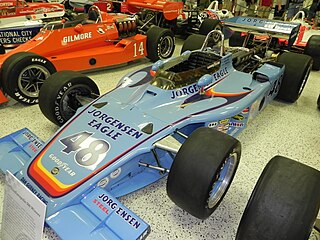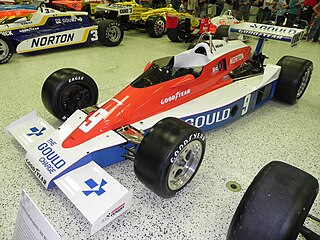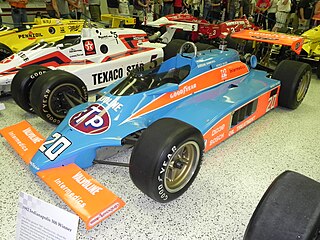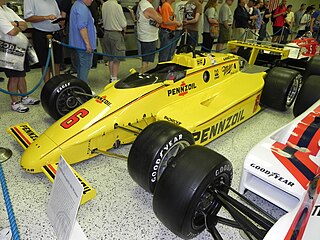
The 54th 500 Mile International Sweepstakes was held at the Indianapolis Motor Speedway in Speedway, Indiana on Saturday, May 30, 1970.

The 56th 500 Mile International Sweepstakes was held at the Indianapolis Motor Speedway in Speedway, Indiana, on Saturday, May 27, 1972. The race is notable in that for the first time, the cars were permitted bolt-on wings, and speeds climbed dramatically. Bobby Unser won the pole position at a then-remarkable speed of 195.940 mph (315.3 km/h) for four laps, breaking Peter Revson's track record of 178.696 mph (287.6 km/h) from 1971 by 17.244 mph (27.8 km/h) – the largest one-year track record increase in Indy history. The race average speed of 162.962 mph (262.3 km/h) was also a new record, which stood until 1984.

The 57th 500 Mile International Sweepstakes was held at the Indianapolis Motor Speedway in Speedway, Indiana, on Wednesday, May 30, 1973. The race was held over three days because of rain and two major accidents. Three competitors—two drivers and one pit crew member—died from injuries suffered as a result of accidents that occurred during the month, another driver was critically injured, and over a dozen spectators suffered injuries and/or burns. After 133 laps, rain halted the race, and Gordon Johncock was declared the winner, the first of his two Indy triumphs.

The 58th 500 Mile International Sweepstakes was held at the Indianapolis Motor Speedway in Speedway, Indiana on Sunday, May 26, 1974. Johnny Rutherford, in his eleventh attempt, won the race from the 25th starting position, the farthest back since Louis Meyer in 1936. It was the first of his three Indy victories, and started a three-year stretch where he finished 1st-2nd-1st.

The 59th 500 Mile International Sweepstakes was held at the Indianapolis Motor Speedway in Speedway, Indiana on Sunday, May 25, 1975. A. J. Foyt started on the pole position and Bobby Unser won his second Indianapolis 500. Dan Gurney, one of the founders of All American Racers, who finished second as a driver himself in 1968–1969, won his first and only Indy 500 as a car owner. Gurney's Eagle chassis itself scored its third "500" win. The race was part of the 1975 USAC National Championship Trail.

The 61st 500 Mile International Sweepstakes was held at the Indianapolis Motor Speedway in Speedway, Indiana on Sunday, May 29, 1977. Considered one of the most historically significant editions of the Indianapolis 500, several sidebar stories complemented the unprecedented accomplishment of race winner A. J. Foyt. Foyt became the first driver to win the Indianapolis 500 four times. As of 2024, Foyt's record has been tied by Al Unser Sr., Rick Mears and Hélio Castroneves, but still stands as an Indy 500 record. Foyt's victory is also the last time the winning car was built entirely within the United States.

The 62nd 500 Mile International Sweepstakes was held at the Indianapolis Motor Speedway in Speedway, Indiana on Sunday, May 28, 1978. Danny Ongais dominated the early stages of the race but eventually dropped out with a blown engine. Al Unser Sr. dominated the second half, and held a large lead late in the race. However, Unser bent the front wing of his Lola during a pit stop on lap 180, causing his handling to go away over the final twenty laps. Second place Tom Sneva charged to catch Unser's crippled Lola but came up 8 seconds short at the finish line – the second-closest finish in Indy history to that point. Unser held off the challenge, and became a three-time winner of the 500. It was Al Unser's third Indy victory in the decade of the 1970s, and the fifth of nine overall victories by the Unser family.

The 63rd 500 Mile International Sweepstakes was held at the Indianapolis Motor Speedway in Speedway, Indiana, on Sunday May 27, 1979. Second-year driver Rick Mears took the lead for the final time with 18 laps to go, and won his first of four Indianapolis 500 races. It was also Mears' first of a record six Indy 500 pole positions. Brothers Al and Bobby Unser combined to lead 174 of the 200 laps, but Al dropped out around the midpoint, and Bobby slipped to 5th place at the finish nursing mechanical issues. It was also Roger Penske's second Indy 500 victory as a car owner.

The 64th 500 Mile International Sweepstakes was held at the Indianapolis Motor Speedway in Speedway, Indiana on Sunday, May 25, 1980. Johnny Rutherford won the pole position, led 118 laps, and won the race by a commanding 29.92 second margin. After failing to finish the race the year before, Jim Hall's radical new Chaparral 2K ground effects chassis was a heavy favorite entering the month, and drove a flawless race. Rutherford, the winner in 1974 and 1976, became the sixth driver to win the Indy 500 three times.

The 66th Indianapolis 500 was held at the Indianapolis Motor Speedway in Speedway, Indiana on Sunday, May 30, 1982. Gordon Johncock, who had previously won the rain-shortened 1973 race, was the winner. Polesitter Rick Mears finished second by a margin of 0.16 seconds, the closest finish in Indy 500 history to that point.

The 71st Indianapolis 500 was held at the Indianapolis Motor Speedway in Speedway, Indiana, on Sunday May 24, 1987. After dominating practice, qualifying, and most of the race, leader Mario Andretti slowed with mechanical problems with only 23 laps to go. Five laps later, Al Unser Sr. assumed the lead, and won his record-tying fourth Indianapolis 500 victory. At age 47, just days short of his 48th birthday, Unser became the oldest winner of the Indy 500, a record that still stands as of 2024. During the month of May, an unusually high 25 crashes occurred during practice and qualifying, with one driver in particular, Jim Crawford, suffering serious leg injuries.

The 68th Indianapolis 500 was held at the Indianapolis Motor Speedway in Speedway, Indiana on Sunday May 27, 1984. Rick Mears, who previously won in 1979, won his second Indy 500 victories driving for Penske. Contenders Tom Sneva and Mario Andretti dropped out of the race in the second half, leaving Mears alone two laps ahead of the field, and he cruised to the victory. Three months after the race, however, Mears would suffer severe leg injuries in a practice crash at Sanair.
The 1979 SCCA/CART Indy Car Series was the inaugural Championship Auto Racing Teams (CART) American open wheel racing championship series. The season consisted of 14 races. Rick Mears was the national champion, and the rookie of the year was Bill Alsup. The 1979 Indianapolis 500 was sanctioned by USAC, but counted towards the CART points championship. Rick Mears won the Indy 500, his first of four victories in the event.

The Pocono 500 was an IndyCar Series race held at Pocono Raceway in Long Pond, Pennsylvania, located in the Pocono Mountains. The first Indy car race at Pocono was held in 1971. It was the first major event held at the track, shortly after its completion. The race was sanctioned by USAC from 1971 to 1981, and then by CART from 1982 to 1989, and was known as the Pocono 500. The race was removed from the CART calendar following the 1989 running, due to poor track conditions, as well as poor revenue for the promoter.

The 1971 Pocono 500, the inaugural running of the event, was held at the Pocono Raceway in Long Pond, Pennsylvania, on Saturday, July 3, 1971. Branded as the 1971 Schaefer 500 for sponsorship reasons, the race is notable as the first IndyCar win for Team Penske and the first for driver Mark Donohue.

The 1972 Pocono 500, the 2nd running of the event, was held at the Pocono Raceway in Long Pond, Pennsylvania, on Saturday, July 29, 1972. Branded as the 1972 Schaefer 500 for sponsorship reasons, the race was won by Joe Leonard. The race is notable for its impact by Hurricane Agnes and the confrontation between the track and USAC.

The 1973 Pocono 500, the 3rd running of the event, was held at the Pocono Raceway in Long Pond, Pennsylvania, on Sunday, July 1, 1973. Branded as the 1973 Schaefer 500 for sponsorship reasons, the race was won by A. J. Foyt who passed Roger McCluskey on the last lap.

The 1971 California 500, the second running of the event, was held at the Ontario Motor Speedway in Ontario, California, on Sunday, September 5, 1971. The event was race number 10 of 12 in the 1971 USAC Championship Car season. The race was won by Joe Leonard.

The 1972 California 500, the third running of the event, was held at the Ontario Motor Speedway in Ontario, California, on Sunday, September 3, 1972. The event was race number 8 of 10 in the 1972 USAC Championship Car season. The race was won by Roger McCluskey, his first 500-mile Indy Car victory. In qualifying, Jerry Grant became the first IndyCar driver to ever break to 200 mile per hour barrier.

The 1973 California 500, the fourth running of the event, was held at the Ontario Motor Speedway in Ontario, California, on Sunday, September 2, 1973. The event was race number 11 of 16 in the 1973 USAC Championship Car season. The race was won by Wally Dallenbach Sr., his only 500-mile Indy Car victory.















